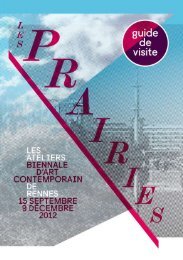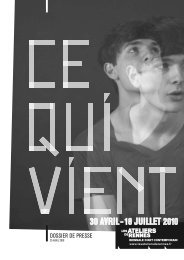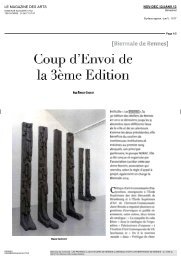Download here the Visitor's guide. - Les Ateliers de Rennes
Download here the Visitor's guide. - Les Ateliers de Rennes
Download here the Visitor's guide. - Les Ateliers de Rennes
You also want an ePaper? Increase the reach of your titles
YUMPU automatically turns print PDFs into web optimized ePapers that Google loves.
62<br />
<strong>Les</strong> Prairies's artists<br />
URIEL ORLOW<br />
Remnants of <strong>the</strong> Future, 2010. Diffusion LUX. Courtesy of <strong>the</strong> artist.<br />
Nasrin Tabatabai (born in 1961 in Iran) and Babak Afrassiabi (born in<br />
1969 in Iran) had foun<strong>de</strong>d PAGES in 2004 in Rotterdam (Ne<strong>the</strong>rlands)<br />
w<strong>here</strong> <strong>the</strong>y live nad work.<br />
Uriel Orlow is concerned with <strong>the</strong> way collective<br />
memory exists and <strong>the</strong> forms and figures that embody<br />
it in reality (personalities, places, writings, or images).<br />
In his film Remnants of <strong>the</strong> Future (2010), he explores<br />
<strong>the</strong> ruins of Soviet i<strong>de</strong>ology. The public housing estate<br />
at Mush in <strong>the</strong> north of Armenia, was built in 1988 at <strong>the</strong><br />
behest of Mikhail Gorbachev in or<strong>de</strong>r to house people<br />
displaced from <strong>the</strong> Stipak earthquake zone. But after<br />
<strong>the</strong> break-up of <strong>the</strong> Soviet Union in 1991 <strong>the</strong> project was<br />
left in <strong>the</strong> air. The estate, an i<strong>de</strong>alistic communal living<br />
project, is now inhabited only by temporary settlers and<br />
scavengers who strip scrap metal out of <strong>the</strong> buildings.<br />
This ghost city fits Foucault's notion of heterotopia,<br />
insofar as, never having been finished, it does not<br />
figure on any map – a phantasmagorical place even<br />
though it exists. Mush is named after a city in Anatolia<br />
in Eastern Turkey. It is <strong>the</strong> subject of Plans for <strong>the</strong> Past<br />
(2012), <strong>the</strong> second part of Remnants of <strong>the</strong> Future. The<br />
city of Mush in Anatolia also seems to have been<br />
suspen<strong>de</strong>d in time. It was <strong>the</strong> scene of <strong>the</strong> massacre<br />
of <strong>the</strong> Armenians, <strong>the</strong> first recognized genoci<strong>de</strong> in<br />
20th century history, although <strong>de</strong>nied and disputed by<br />
successive Turkish governments.<br />
M. C. tr J. H.<br />
Bron in 1973 in Zurich (Switzerland), lives and works<br />
around London and Zurich.<br />
NASRIN TABATABAI & BABAK AFRASSIABI (PAGES)<br />
Through <strong>the</strong>ir research projects and <strong>the</strong>ir bilingual Anglo-Persian<br />
journal, Nasrin Tabatabai and Babak Afrassiabi explore <strong>the</strong> historical,<br />
political, and cultural conditions for <strong>the</strong> production of art in <strong>the</strong> specific<br />
context of Iran. Two Archives (2011) combines two different sources: <strong>the</strong><br />
archives of <strong>the</strong> British Petroleum company (BP) and <strong>the</strong> collection of<br />
mo<strong>de</strong>rn Western art from <strong>the</strong> Museum of Contemporary Art in Teheran.<br />
BP was in Iran from 1901 until 1951, when oil was nationalised and it<br />
lost its monopoly. The BP archives document <strong>the</strong> history of <strong>the</strong> first oildrilling<br />
operations in <strong>the</strong> Middle East. In 1970, when oil exports were at<br />
<strong>the</strong>ir highest, <strong>the</strong> Teheran Museum of Contemporary Art held <strong>the</strong> largest<br />
collection in <strong>the</strong> Middle East, thanks to money from an oil company. In<br />
<strong>the</strong> exhibition space, an assembly of two oil <strong>de</strong>rricks and a copy of <strong>the</strong><br />
two open halves of a refinery ventilation housing stand as an echo of<br />
mo<strong>de</strong>rn sculpture. The vi<strong>de</strong>o is a loop that overlays a shot of <strong>the</strong> workers<br />
leaving <strong>the</strong> workplace with <strong>the</strong> same shot in reverse. Going home thus<br />
becomes a return to <strong>the</strong> refinery. A replica of a photo album documents<br />
<strong>the</strong> architecture of company housing, while a series of letters retraces a<br />
correspon<strong>de</strong>nce about making a flattering and i<strong>de</strong>ological documentary<br />
about <strong>the</strong> company. The pictures are inspired by photographs in <strong>the</strong><br />
museum's reserves. The combination of <strong>the</strong>se two archives makes<br />
manifest <strong>the</strong> unfinished nature of Iran's mo<strong>de</strong>rnity, which has been<br />
partly fashioned by <strong>the</strong> oil economy since <strong>the</strong> early 20th century.<br />
F. O. tr. J. H.<br />
Woo<strong>de</strong>n Oil Derrick Superimposed with Steel Oil<br />
Derrick, Two Archives, 2011. Installation view, Badischer<br />
Kunstverein, Karlsruhe (Allemagne) 2011.<br />
Photography : Stephan Baumann.






